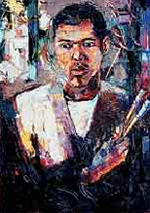Ephraim Mojalefa Ngatane was born in Maseru, Lesotho (then Basutoland) in 1938. He moved to Johannesburg in about 1943, where he was educated at the Mooki Memorial School. His talent was recognised and encouraged from an early age by his teacher, Mrs E.L. Mooki, and later at Orlando High School in Soweto.
Ephraim Ngatane's work epitomizes the period where the first professional African Artists, mainly concerned with the social conditions of their segregated settlements, emerged through the Polly Street Art Centre in the 1950’s. Ngatane studied painting at the Centre between 1952 and 1954, under Cecil Skotnes. His experience of the shantytowns and townships of the Witwatersrand formed the focus of his work. Eventually, Ngatane went on to teach at the centre.
 Figure 1: Old Orlando, 1969 Oil on masonite. Source: Neglected tradition
Figure 1: Old Orlando, 1969 Oil on masonite. Source: Neglected tradition
Although he was an important figure in its environment, and credited with influencing and developing several major talents – notably those of Dumile Feni, Louis Maqhubela and Ben Macala – Ngatane’s concern was for an often politically charged, though equally often celebratory, documentary realism. He developed an individual approach to the painting of township scenes using watercolour and later, in the mid 1960s, oil paints. His scenes were accurate recordings of specific places in the township e.g. his painting Old Orlando, 1969 Oil (figure 1).
 Figure 2: Snowfalls in the Transvaal on 14 and 15 July 1967. Source. michaelstevenson.com
Figure 2: Snowfalls in the Transvaal on 14 and 15 July 1967. Source. michaelstevenson.com
From 1954 to 1956 Ngatane studied art under Hall Duncan, an American missionary of St Peter's College in Rosettenville. In 1955, Ngatane joined the seminal ‘Weekend Painters’ group initiated by Durant Sihlali – from whom he also received some instruction at the Polly Street and Jubilee Centres. He also taught at the Jubilee Centre after 1954. In the debate which characterised the weekend workshops, other, more naturalistic and documentary options were explored than those promoted in the formal teaching situation; a distinctively painterly, “psychologising” and realist tenor then came to characterise Ngatane’s work. In 1960, Ngatane’s work was publicly shown for the first time in the ‘Artists of Fame and Promise’ Exhibition, at the Johannesburg Art Gallery.
On 2 January 1963 Ngatane held his first solo show at the Adler Fielding Gallery, and in 1964 he held his second exhibition in Johannesburg. During this time, Ngatane made ends meet by painting ceramic pots at the Majolica Pottery in Doornfontein, Johannesburg.
Later that year, the artist was hospitalised with tuberculosis at the Charles Hurwitz South African National Tuberculosis Sanatorium in Soweto. It was during his confinement that he encountered and inspired the young Dumile Feni, who found in Ngatane a model for his own headstrong practice as an artist. Ngatane and Dumile produced a series of murals at the sanatorium, most of which however, have subsequently been painted over.
 Figure 3: Portrait of Dumile Mslaba (1964). Source: artthrob
Figure 3: Portrait of Dumile Mslaba (1964). Source: artthrob
Over time, his work explored several different registers – from documentary realism to an abstract painting. In the latter, he fragmented the forms of the houses and people to the point where they disintegrate into amorphous shapes over which he has superimposed a rhythmic grid of lines to intertwine the elements of the image (figure 2). Another register explored was the politically charged use of religious symbolism.
What defines the importance of Ngatane’s work, as well as his influence on his contemporaries, is its uncompromising concern for the gritty and atmospheric representation of township experience in the South African context of the time.
Apart from being a painter whose importance in the development of South African traditions is increasingly acknowledged, Ngatane was also an accomplished alto-jazz saxophonist.
He died of tuberculosis in 1971 at 33 years of age.